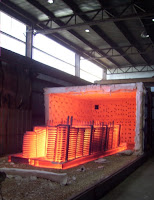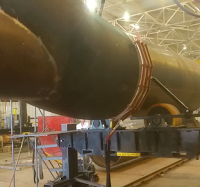Preliminaries: What is an arc?
Inert gases used in welding, helium and argon, are made up of loose atoms flying around and banging against themselves and the walls of their container. At high temperatures the atoms speed up and negatively charged electrons are knocked off the atoms. A plasma is a kind of soup of little, fast-moving, negative electrons, neutral atoms, and big, slow-moving, positively charged ions (what's left of an atom after electrons have been knocked off). Plasmas are neutral because the charge of the ions and electrons balance, but because the electrons and the ions can move independently, plasmas conduct electricity like metals. Plasmas can be started by applying a high electric field to a gas. The electric field (volts per distance) picks up a stray electron and slams it into a neutral atom hard enough to knock out more electrons. An electron avalanche takes place and starts a plasma. This happens when an arc is struck. A high frequency current can do it, too.
As plasma cools off, the electrons move more slowly and are recaptured, and the plasma is no more unless the energy loss to its surroundings is replenished. A voltage imposed on a plasma accelerates the conducting charges and can maintain a plasma indefinitely. A welding arc is a plasma maintained between oppositely charged electrodes. In the GTA (gas, Tungsten, arc) process one electrode is a tungsten rod; the other is the workpiece.
The arc column itself is hot, say 10,000 to 20,000 °C. A voltage drop of around one volt per millimeter is typical for an arc column. Thus if the arc is conducting a 100 amp current, about 100 watts of power is needed to maintain a millimeter of arc column, around the same as a light bulb. The really important voltage drops, through which the electrodes are heated, occur at the electrodes. This will be discussed below.
How a PAW Torch Works
A plasma torch is like a little rocket engine. The plasma is initiated by a high frequency AC voltage in a chamber inside the torch in an inert "plasma gas." As the plasma gas is fed into the chamber it heats up and expands as well as ionizes. The hot gas rushes out through a water-cooled nozzle as a plasma jet.
The plasma jet can be used directly as a heat source, but usually the arc is transferred to the workpiece. The internal "pilot arc" is no longer necessary once the transference takes place. The transferred arc still heats the plasma gas inside the torch and the plasma gas still rushes out as a plasma jet.
Keyholing
The plasma jet makes a particularly stable arc with less tendency to wander erratically and somewhat greater concentration than a GTAW arc. It is not so sensitive to standoff distance as is a GTAW torch. But especially useful is the ability to operate in the "keyhole" mode.
The plasma jet has kinetic energy that produces a pressure when it impinges against a weld pool. The pressure is enough to push a centimeter or two into a pool of liquid metal, so that a plasma arc can penetrate into the workpiece like an electron beam or a laser, although the penetration mechanism is not the same. Hence plasma arc welds can be deeper and narrower than GTA welds. The number of weld passes can be reduced in changing from GTAW to PAW.
When the PAW process is operated with the arc penetrating all the way through the workpiece the operation is said to be in the "keyholing" mode. The arc impinges on the forward surface of the "keyhole." Melted metal flows around the sides of the keyhole and the streams join behind the keyhole. (The flow of metal is driven by variations in surface tension with temperature, i.e. thermocapillary forces.)
In metals that form tenacious oxides, or sometimes due to contamination in spite of the shield gas used to envelope and protect the keyhole, an oxide layer reminiscent of plastic wrap covers the converging streams of molten metal. A lumpy non-weld results.
But keyholing has a tendency to blow away weld seam contaminants. Where weld seam contamination is a problem PAW in the keyholing mode might be considered. Porosity in aluminum alloys might be reduced in this way. In the latter case special measures need to be taken to avoid problems from the tenacious oxide on the surface of aluminum.
Polarity and Why It Matters
At the cathode or negative electrode the temperature must be high enough so that the electron emission process keeps the arc supplied. Otherwise the arc goes out. The needed heat is generated when the cooled end of the arc increases in resistance and produces a voltage drop. The heat replenishes the heat conducted away by the electrode metal, the energy required to pull each electron out of the metal, and the energy required to heat each electron to the plasma temperature.
The energy to pull an electron out of a metal is expressed as a voltage drop called the "work function." At the anode or positive electrode the heat that must be supplied to maintain equilibrium is approximately (neglecting thermal radiation effects) the heat conducted away by the electrode metal. Besides heat generated by the higher resistance of a locally cooled plasma, heat is brought to the surface by the amount of the energy gained when an electron enters the electrode metal (work function) and by the greater plasma temperature of the entering electrons.
Because the electrons extract heat from the cathode and deliver heat to the anode, the welding process is considered to be more efficient when operated in "straight polarity," when the torch electrode is negative, the workpiece positive, and electrons flow to the workpiece. Unless there's a reason not to, welding torches are operated in the straight polarity mode.
But there is a reason to weld in "reverse polarity," where the electrons flow away from the workpiece: the cathodic cleaning effect. A high speed movie of the vicinity of a GTA weld pool in the reverse polarity mode will reveal a display of sparkling points of light, miniature explosions continually occurring all over the surface. This is thought to be caused by electrostatic breakdown of a thin surface oxide layer. The positive ions in the arc accumulate on the surface of the oxide layer and induce a balancing negative charge. If the oxide layer is thin, it doesn't take a lot of charge to produce an electric field (volts per distance) big enough to cause the oxide layer to break down in a mini-explosion. Cleaned surface is distinct and visible around the crown of a weld made in reverse polarity. But to get the cleaning necessary to weld aluminum alloys one takes a hit in power available for welding, and the effective capability of the machine is reduced.
Abstracted from a 2004 NASA document by Arthur Nunes.







